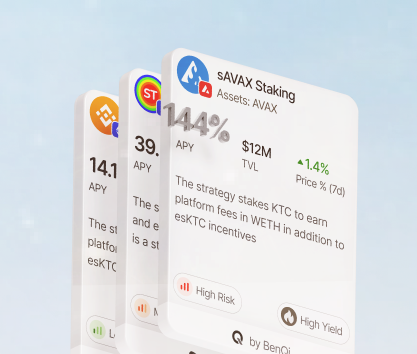When it comes to farming yields in the DeFi ecosystem, stablecoins are among the best digital assets to work with because they are, as the name suggests, stable and serve as a reference to many retail traders and investors. The current undisputed king among them is USDC which has recently pushed aside the previous dominant asset in the DeFi sector USDT.
The DeFi sector offers a rich selection of viable approaches to farming rewards. From yield curve strategies, which can be executed on protocols like Pendle offering pools with different maturation periods, to liquid staking allowing you to increase exposure in exchange for increased yields. For instance, you can invest in the SUSDE for LP pool on Pendle and plot returns on a curve just like you would in the case of US treasury bonds. The three-month October yield curve is 18.24% to 12.43% APY with 30-day averages slightly underperforming.
DeFi stablecoin farming
The variety of options for stablecoin yield farming is quite impressive. Almost all popular protocols offer some stablecoin pools. DEXes need them to keep user activity high and lending platforms have to amass huge volumes of USDC, USDT, DAI, and other stables since their utilization is usually the highest after BTC and ETH.
Below are three main ways to earn rewards through stablecoin staking:
- Investing in high-risk/high-reward pools for the highest potential return.
- Providing liquidity to reliable DEXes in exchange for their native coins.
- Lend tokens via specialized decentralized protocols like Compound and Aave.
In some cases, you can also use leverage in stablecoin farming by investing in leveraged pools or taking a loan against staked tokens received from liquid staking protocols like Lido. Note that borrowing always increases your exposure and can lead to unsustainable losses. It is hugely important to carefully consider all available options before using leverage to increase potential gains. Using liquid staking platforms to take out loans in stablecoins can be also less efficient if the ratio is unfavorable.
High-yield stablecoin pools
Multiple protocols are offering obscenely high rewards to attract users as quickly as possible to increase activity, engagement, and liquidity. The competition in the DeFi ecosystem is incredibly fierce making it quite important to make decisive moves. Several DEXes have quite good pools:
- Aerodrome on Base allows users to invest in the OVN-USD+ pool for a massive 254% reward APY paid in AERO tokens which have been performing well throughout the last year.
- Curve DEX has an XSTABLE pool with a 0.42% base APY and up to 141% in CRV rewards which are also very valuable and have healthy price fluctuations.
- Ekubo on StarkNet offers a lucrative ETH-USDC pool (TVL is over $6.2 million) with a 13.26% base APY and 37.38% in STRK rewards.
Note that we don’t take into consideration pools with TVL lower than $5 million, and still returns are quite impressive.
Compound, Aave, Navi Lending, and many others offer stablecoin pools to both lenders and borrowers. It is a good way of earning additional rewards since many such protocols usually have relatively low base APYs yet can pay handsomely in native tokens. Below are some examples:
- Aries Markets on Aptos offers users an opportunity to invest in a limited-time ZUSDC pool for a healthy 4.99% base APY and up to 6.6% in APT rewards.
- Fluid on Ethereum has a solid USDC pool with an $86 million TVL. You can expect an impressive 7.38% base APY and 3.52% in USDC rewards.
- Morpho Blue has a great offering in the form of its TBTC-USDC pool with a massive 9.06% base APY and 2.02% in WETH rewards.
Usually, lending protocols have APYs lower than 0.1% but APYs can go quite high when utilization improves. In many senses, these protocols are safer than many others since all loans are collateralized. However, impermanent loss mitigation techniques must be employed by investors to reduce the exposure! In the end, these platforms are overcollateralized and have been suffering from unexpected liquidations due to severe price fluctuations which happen in the crypto market way too often.
Stable asset liquidity provision
All DEX platforms have to compete for liquidity to attract more users and deliver a satisfactory user experience. With over 1,400 different DEXes across 90+ chains, the competition in the sector is fierce which is good for an average investor who can allocate capital to pools that offer generous rewards and incentive structures.
Here are some great examples of stablecoin liquidity pools on various exchanges:
- The USDC-AERO pool on Aerodrome promises a hefty 55% reward APY paid in AERO tokens. It is one of the most profitable options in October 2024.
- PancakeSwap offers a solid WETH-USDT pool with 10.64% base APY and up to 8.28% in CAKE rewards with a 16% 30-day mean average.
- Cetus AMM on Sui has a 0.01% USDT-USDC pool 1.69% base APY and 5.69% reward APY with a 9.41% 30-day average.
Multi-chain yield optimization
It is true that you should be trying to diversify investments. The debate between investors who believe in putting eggs in different baskets and those who want to carry everything at once is still unsettled. Some scholars think that concentrated portfolios are better while others are trying to prove that diversification should be prioritized. Regardless of where you find yourself on this spectrum, it is a good idea to allocate capital to multiple chains.
It can be done through several methods:
- Use liquid staking platforms. For example, you can stake ETH with Lido on the mainnet for 2.99%. stETH can be used as collateral on Aave to take out a USDC loan. Stablecoins are easily moved from one chain to another using bridges. Some of them also offer rewards. Among such cross-chain bridges for yield is Across pays 1.16% base APY on USDC holdings and up to 5.95% in ACX rewards.
- Put capital into multiple stablecoin pools. Investing in the TON-USDT pool on DeDust yields 2.52% as a base and 19.04% in TON rewards. Simultaneously, you can invest some of USDT in the two-sided USDC-USDT pool on Cellana Finance (Aptos) for 18% in CELL. You can also invest in chain-specific stablecoins like DAI on Ethereum or USD+ on Optimism.
In some cases, using so-called automated yield harvesters like Yearn Finance or Beefy can be a good choice specifically for scenarios where you want to spread capital across multiple different chains. These protocols are great when you don’t want to focus on managing your investments. Manual harvesting is less precise than automatic so you will never miss out on potential rewards.
Stablecoin yield strategies
The best approach to maximizing profitability while avoiding excess risks is through the use of various hedging techniques allowing you to create a delta-neutral position. This particular method involves derivatives or leveraged trading as you need to create short positions for each instance of staking. It is the best risk-reduction trick that crypto investors have.
However, there are other means of reducing exposure while maintaining a healthy level of profitability. We strongly suggest taking the following risks into consideration and building your portfolio around them:
- Smart contract vulnerabilities. Flash loan attacks are commonly used against protocols that utilize uncollateralized lending procedures to generate revenues. Since lenders are often encouraged to work with these lending protocols due to their implied safety, it is easy to be carried away by the promises of high returns. However, exploits can be found by bad actors. Usually, such attacks do not affect users. Nonetheless, it is hugely important to work with protocols that have strong safety measures in place. For example, they can utilize external smart contract audits to ensure their strength.
- The lack of regulatory oversight. The DeFi ecosystem is the modern version of the Wild West. Rules and punishment for misbehavior do not exist making it quite challenging for many users to protect themselves against various risks and protocol failures. If you lose money in a shady or questionable investment, there will be no legal recourse. Without consumer protection, the sector often attracts scammers.
- Market volatility. If you want to harvest yields in native or governance token rewards, it is crucial to track market prices to estimate potential gains. The vast majority of new tokens in the market quickly lose value due to rapid inflation caused by the exodus of early investors cashing out and selling their rewards. Timing your exit is incredibly important when engaging in strategies like stablecoin yield farming and others.
These risks among many others including impermanent loss, overcollateralization of the lending sector, liquidity issues, and more should be considered by capital holders when building a robust investment strategy.
Risk-adjusted stablecoin returns
The DeFi ecosystem has matured sufficiently enough to have a variety of different investment instruments that can be used to calculate risk premiums. Standard approaches like Sharpe or Treynor ratios can work for DeFi protocols and their many pools. However, it is important to use comparable references and baselines to identify which is riskier.
In many cases, you will be investing in unique assets that do not have comparable counterparts in the tradfi sector. For instance, it is quite hard to analyze an appropriate level of riskiness for algorithmic stablecoin yield. Take DAI as an example. The return rate on this stablecoin is 6% if you stake it with MakerDAO through the DSR module.
Compare this return to the US Treasury bond APR which was 4.11% in September 2024. DAI is pegged to the US dollar meaning that you are receiving a 1.89% risk premium for switching from bonds to DAI staking. Is that enough to cover potential risks associated with still untested algorithmic coins? There is no good comparison aside from extreme examples like Terra Luna’s collapse or novel arrivals to the market like GHO.
The main takeaway
Identifying the best strategy for yield farming using stablecoins is difficult even for experienced veterans of the crypto market since many instruments appeared just a couple of years ago and still require additional testing and maturation. We recommend keeping a distance from questionable memecoins and investing in high-TVL projects while trying to do as much research as possible!









